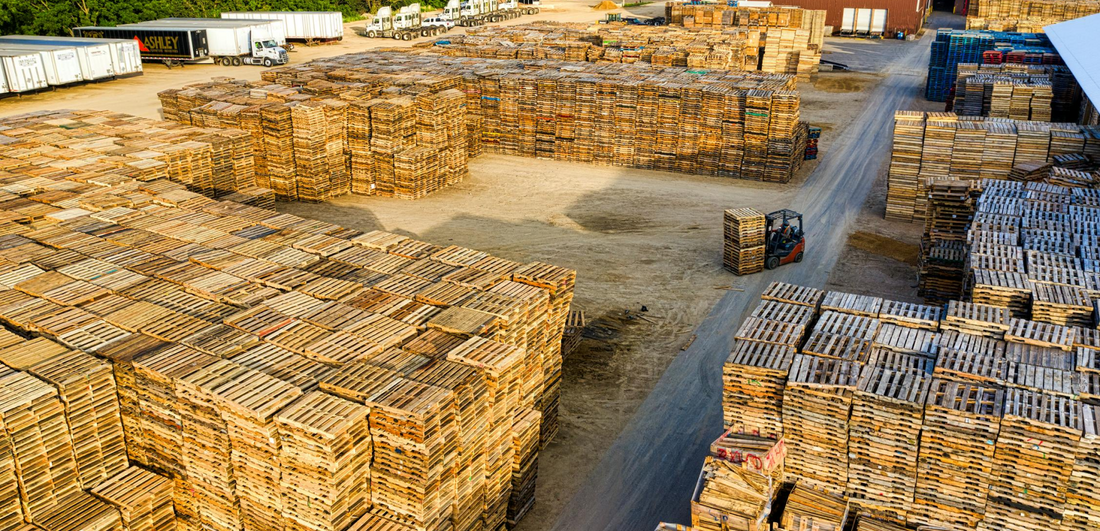
Warum sind Paletten wichtig, und worin liegt ihr Wert?
Share
Im modernen Geschäftsleben sind Logistik und Lieferkettenmanagement unverzichtbare Bestandteile des Betriebs. Vom kleinen Geschäft bis hin zu großen multinationalen Unternehmen steht jedes Unternehmen vor der Herausforderung, Waren zu transportieren und zu lagern. Holzpaletten, als eines der Kernelemente der Transportinfrastruktur, spielen dabei eine entscheidende Rolle. In diesem Artikel erklären wir, warum Paletten so wichtig sind, welche Vorteile sie bieten und warum sie in der heutigen Welt unverzichtbar sind.
Die Geschichte der Paletten
Die ersten Erwähnungen von Prototypen moderner Paletten stammen aus dem frühen 20. Jahrhundert. Während der industriellen Revolution führten Fortschritte in der Transporttechnik dazu, dass Werkzeuge entwickelt werden mussten, um den Warentransport zu vereinfachen.
Anfangs wurden Holzplattformen ohne standardisierte Größen verwendet. Mit der Erfindung der ersten Gabelstapler in den 1930er Jahren wurde jedoch schnell klar, dass universelle Designs erforderlich waren, um Ladungen maschinell heben und bewegen zu können. So entstanden Holzpaletten, die in der Logistik rasch an Popularität gewannen. Später, im Jahr 1961, wurde der EURO-Standard eingeführt, der einheitliche Palettengrößen in ganz Europa gewährleistet.
Heute sind Paletten ein wesentlicher Bestandteil der Weltwirtschaft. Ihre Vielseitigkeit, Einfachheit und Effizienz haben ihnen eine unverzichtbare Rolle in logistischen Systemen gesichert.
Was sind Holzpaletten und welche Arten gibt es?
Holzpaletten sind flache Plattformen aus Holzbrettern, die für die Platzierung und den Transport von Waren entwickelt wurden. Die Hauptkomponenten einer Palette sind:
- Deckbretter (obere Fläche).
- Klötze oder Kufen (mittlere Stütze).
- Bodenbretter (Basis).
Es gibt verschiedene Arten von Holzpaletten, die sich in Konstruktion, Abmessungen und Verwendungszweck unterscheiden:
-
Europaletten (EPAL)
Diese standardisierten Paletten messen 1200 x 800 mm und sind aufgrund ihrer Vielseitigkeit und Zuverlässigkeit in Europa weit verbreitet. -
Amerikanische Paletten (GMA)
Mit einer Größe von 1200 x 1000 mm sind diese Paletten in Nordamerika beliebt und eignen sich hervorragend für den Transport von sperrigen Gütern. -
Einwegpaletten
Leichte und kostengünstige Optionen, die für einmalige Transporte verwendet werden. Sie eignen sich für Fälle, in denen die Paletten nicht zurückgegeben werden sollen. -
Beidseitig nutzbare Paletten
Robuste und langlebige Konstruktionen, die von beiden Seiten verwendet werden können. -
Sonderpaletten
Werden auf Bestellung für den Transport spezifischer oder empfindlicher Güter, wie Glas oder Haushaltsgeräte, hergestellt.
Vorteile der Verwendung von Holzpaletten
Holzpaletten erleichtern nicht nur den Transport, sondern lösen auch zahlreiche Herausforderungen im Zusammenhang mit Lagerung, Schutz und Logistik. Hier sind die wichtigsten Vorteile:
-
Kostensenkung in der Logistik
Mit Paletten können große Mengen an Produkten auf einmal transportiert werden, wodurch die Kosten für Transport und Arbeitskraft gesenkt werden. -
Vereinfachte Lagerprozesse
Paletten können übereinander gestapelt werden, wodurch der Lagerraum effizient genutzt wird. Dies ist besonders wichtig für Unternehmen mit begrenztem Lagerplatz. -
Erhöhte Sicherheit der Waren
Auf Paletten gelagerte Produkte sind weniger anfällig für mechanische Beschädigungen, Verschmutzungen und Feuchtigkeit. -
Umweltfreundlichkeit
Holz ist ein natürlicher und erneuerbarer Rohstoff. Abgenutzte Paletten können repariert oder recycelt werden, was sie zu einer nachhaltigen Lösung macht. -
Vielseitigkeit
Paletten eignen sich für den Transport verschiedenster Güter, von Lebensmitteln bis hin zu schwerem Gerät. -
Internationale Standards
Standardisierte Palettengrößen vereinfachen die globale Logistik und ermöglichen einen nahtlosen Transport zwischen Ländern und Kontinenten.
Wie werden Paletten in verschiedenen Branchen eingesetzt?
-
Produzierende Unternehmen
Paletten sind in den Phasen der Verpackung und des Warentransports unverzichtbar. Beispielsweise werden in der Lebensmittelindustrie Kartons mit Produkten auf Paletten angeordnet, bevor sie an Geschäfte versandt werden. -
Logistikunternehmen
Paletten erleichtern den Prozess des Be- und Entladens von Gütern und machen den Betrieb von Lagertechnik effizienter. -
Einzelhandel
Supermärkte und Kaufhäuser erhalten oft Waren, die auf Paletten verpackt sind, was die Platzierung der Produkte in den Regalen erleichtert. -
Bauindustrie
Paletten werden für den Transport von Baumaterialien wie Ziegeln, Zement und Fliesen verwendet. -
Internationaler Handel
In der globalen Logistik machen es die EPAL- und GMA-Standards einfach, Export- und Importprozesse vorhersehbar und unkompliziert zu gestalten.
Ökologische Aspekte der Verwendung von Holzpaletten
Nachhaltigkeit ist heute ein zentrales Anliegen für Unternehmen. Die Verwendung von Holzpaletten unterstützt ökologische Initiativen durch mehrere wichtige Faktoren:
-
Erneuerbarer Rohstoff
Holz ist ein natürlicher Rohstoff, der nachwächst. Für die Herstellung von Paletten werden oft Holzabfälle und minderwertiges Holz verwendet. -
Reparierbarkeit
Beschädigte Paletten können leicht repariert werden, indem defekte Teile ersetzt werden. -
Recyclingfähigkeit
Paletten, die nicht mehr repariert werden können, werden zu Holzspänen verarbeitet oder in der Herstellung von Spanplatten verwendet. -
Reduzierung des CO₂-Fußabdrucks
Durch die Verwendung recycelter Paletten reduzieren Unternehmen das Abfallvolumen und senken die CO₂-Emissionen.
Wie wählt man die richtigen Paletten aus?
Bei der Auswahl von Paletten sollten mehrere Faktoren berücksichtigt werden:
-
Abmessungen der Ladung
Stellen Sie sicher, dass die Größe und Konstruktion der Paletten den Abmessungen der zu transportierenden Produkte entsprechen. -
Gewicht der Ladung
Für schwerere Güter sollten robustere und langlebigere Konstruktionen gewählt werden. -
Transportbedingungen
Wenn die Ladung Feuchtigkeit oder extremen Temperaturen ausgesetzt ist, sollten Paletten mit zusätzlichem Schutz in Betracht gezogen werden. -
Standards
Für internationale Transporte sollten Sie sicherstellen, dass die Paletten den in anderen Ländern akzeptierten Standards entsprechen.
Interessante Fakten über Paletten
- Weltweit werden jährlich über 1 Milliarde Paletten hergestellt, davon 90 % aus Holz.
- Eine durchschnittliche Holzpalette kann ein Gewicht von bis zu 1.000 kg tragen.
- Der EPAL-Standard umfasst mehr als 20 Qualitätskontrollpunkte, was Europaletten zu den zuverlässigsten macht.
Die Zukunft der Holzpaletten
Mit dem Fortschritt der Technologie entstehen neue Ansätze für die Herstellung und Verwendung von Paletten. Beispielsweise entwickeln Unternehmen intelligente Paletten mit Tracking-Sensoren. Diese Sensoren ermöglichen die Standortverfolgung von Waren und die Messung von Umweltfaktoren wie Temperatur und Luftfeuchtigkeit.
Darüber hinaus nimmt der Trend zur Verwendung recycelter Materialien zu. Dies trägt dazu bei, die Umweltbelastung zu verringern und die Herstellung von Paletten nachhaltiger zu gestalten.
Fazit
Holzpaletten sind nicht nur ein logistische Hilfsmittel, sondern auch ein wesentlicher Bestandteil der modernen Wirtschaft. Ihre Verwendung hilft, Transportprozesse zu optimieren, die Sicherheit der Waren zu erhöhen und Kosten zu senken. Dank ihrer ökologischen und funktionalen Vorteile bleiben Holzpaletten ein Eckpfeiler der Logistik.
Wenn Sie Ihr Unternehmen effizienter machen möchten, beginnen Sie mit der Auswahl hochwertiger Paletten. Diese kleine Investition wird sich durch reibungslosere Prozesse und den Schutz Ihrer Waren mehrfach auszahlen.
Bereit, eine Bestellung aufzugeben? Kontaktieren Sie uns, und wir helfen Ihnen, die besten Holzpaletten für Ihre Bedürfnisse zu finden!
